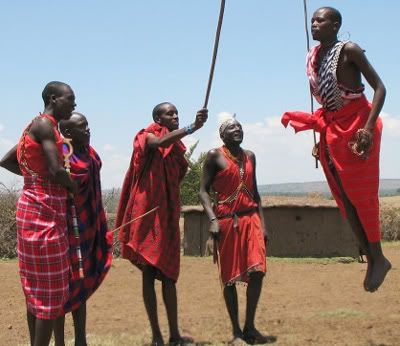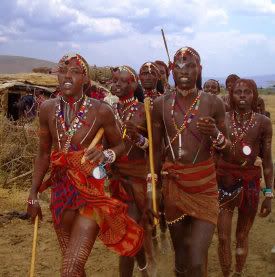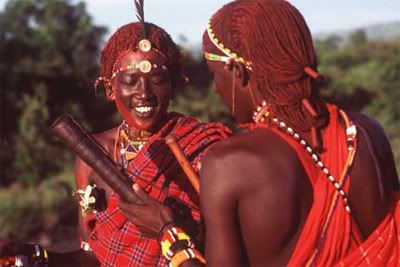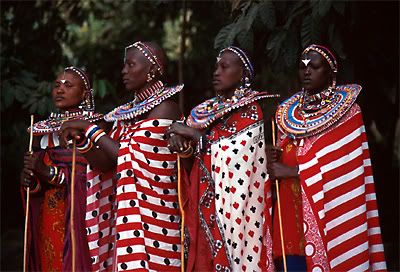
Maasai people in their shukas.
The main garment worn by the Maasai is the shuka, which is a basic piece of fabric that can be worn in a variety of ways, depending on the personal style of the wearer. It was initially made out of animal skins, mostly cowhide but never elephant skin, but cotton is now the main material. The fabric is rubbed with color or dye to make it red, becoming a sort of camouflage with the red dirt of that part of Africa. In the dry grass plains the shuka can be white to camouflage with the grain.

Maasai warriors.
Maasai life is predicated by age sets. For men there are three stages. Childhood, warriorhood, and elderhood. A boy reaches warriorhood around the age of 15, undergoing a series of rituals called almal lengipaata. The warriorhood is the most fabulous time of a mans life, and lasts for about fifteen to twenty years. A young man in warriorhood can be recognized by his appearance. The hair is grown out and braided in very intricate patterns, sometimes using as much as 16 strands at a time. They wear earrings and bracelets, as well as beaded necklaces that hang down the front and back of their bodies. They also wear symbols to show off their achievements. The errap is worn around the top part of the arm, made of leather with coils of metal wire in the front and the back, and shows that this man has fought and killed another man. The Olawaru is a lions mane headdress, meant to show that the man has killed a lion. The enkuwaru is a headdress made of ostrich plumes, meant to show that the man has fought a lion but the lion survived. The body is decorated with white limestone chalk in intricate non-symbolic patterns, and the hair is colored red with ochre and animal fat.

Elaborately braided hair colored with ochre.
The transition from warriorhood to elderhood takes place during a ceremony called the eunoto, which can be extremely traumatic because all of the mans carefully tended hair is shaved off by his mother. The first man to have his head shaved wears a leather cape called an engilaa alamal. The head is then covered in ochre. The elders are expected to take a wife and have children and take on serious responsibilities within the tribe. He will carry a fly whisk made from an elephant tail as a symbol of authority.

Maasai women.
There are only two stages of life for women, childhood and adulthood. A woman enters adulthood after she has undergone circumcision. Mothers of warriors wear surutia, coiled metal medallions. If her son is the first to get his head shaved during the eunoto ceremony, he wears his mothers surutia and it becomes loosurutia. Married women can also wear elongated leather earrings. But the main distinguishing feature for women is their elaborate beaded collars, which are higher in front and lower in back. The collars are made by the women themselves, and thus become more elaborate as women grow and acquire more skill. Heads are shaved to show off the beaded collars, which move around when the women dance.
Beads in particular have some meaning to the Maasai, with red beads having a connection to blood, blue beads having a connection to the heavens and the Gods, and green beads having a connection to prosperity, fertility of the land, and peace. All other colors are purely decorative.